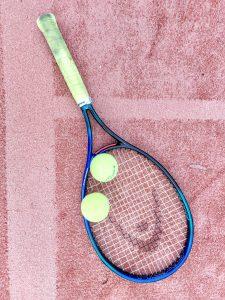We may earn money or products from the companies mentioned in this post.
Introduction to Sliding in Tennis

In the fast-paced and dynamic sport of tennis, players often employ various techniques to gain an edge over their opponents One such technique is sliding, which involves moving swiftly across the court by skidding on one’s feet This skillful maneuver allows players to reach balls that would otherwise be out of their reach and execute shots with precision and agility In this article, we will explore the definition of sliding in tennis, its importance in the game, and the pros and cons of sliding on different court surfaces
Definition of Sliding in Tennis
Sliding in tennis refers to a controlled movement where a player glides across the court surface while maintaining balance and control It involves using momentum and friction to skid on one’s feet rather than coming to a complete stop before changing direction Players typically slide during rapid changes of direction or when attempting to reach wide shots
Importance of Sliding in the Game
Sliding plays a crucial role in enhancing a player’s performance on the tennis court It allows players to maintain their speed and momentum during quick movements, enabling them to cover greater distances efficiently By sliding instead of stopping abruptly, players can quickly recover after hitting powerful shots or returning opponents’ serves
Moreover, sliding provides players with better stability and balance while executing shots It allows them to adjust their body position swiftly, resulting in more accurate strokes Additionally, sliding aids in reducing stress on players’ joints as it absorbs some impact from sudden stops or changes in direction
Pros and Cons of Sliding on Different Court Surfaces
The effectiveness of sliding can vary depending on the type of court surface being played on:
-
Clay Courts:
Sliding on clay courts is highly advantageous due to the soft and slippery nature of the surface It allows players to slide effortlessly, change direction quickly, and reach wide shots with ease The clay also provides better traction, reducing the risk of slipping or losing balance during slides -
Grass Courts:
Sliding on grass courts can be challenging as the surface offers less grip compared to other court types While sliding can still be employed to some extent, players need to be cautious as it’s easier to lose balance or slip on this slippery surface -
Hard Courts:
Sliding on hard courts can put more strain on a player’s body due to the higher friction between the shoes and the surface While it may help in certain situations, excessive sliding can lead to injuries such as sprained ankles or knee problems Players must assess the court conditions carefully before deciding whether sliding is beneficial
In conclusion, sliding is a valuable technique in tennis that enables players to move swiftly and execute shots with finesse It enhances agility, stability, and recovery speed while adding an element of style to a player’s game However, it is essential for players to adapt their sliding technique based on different court surfaces to maximize its effectiveness and minimize potential risks
Techniques for Mastering Sliding in Tennis
In the fast-paced world of tennis, mastering the art of sliding can give you a competitive edge on the court Proper footwork and balance are crucial for executing slides effectively Let’s explore some techniques that will help you improve your sliding game
Proper Footwork and Balance
1 Split-Step Technique:
The split-step technique is the foundation for effective sliding in tennis It involves jumping into the air, landing with your feet shoulder-width apart, and being ready to move in any direction This quick movement helps you anticipate your opponent’s shot and prepares you for a smooth slide
2 The Crossover Step:
The crossover step is an essential footwork technique used during lateral movements on the court To execute this step, cross one foot over the other while maintaining balance and control This allows you to transition smoothly into a slide without losing momentum or stability
3 The Shuffle Step:
The shuffle step is particularly useful when moving backward or forward before initiating a slide It involves shuffling your feet quickly in small steps while keeping your body balanced and centered Mastering this technique will enable you to maintain control during slides in various directions
Correct Body Positioning During a Slide
1 Lowering Your Center of Gravity:
To execute a successful slide, it’s crucial to lower your center of gravity by bending your knees slightly and staying low throughout the movement This position provides better stability and control during slides, allowing you to maneuver with precision
2 Maintaining a Semi-Open Stance:
A semi-open stance allows for better weight transfer while sliding in tennis Keep your hips and shoulders slightly rotated towards the net, creating a balanced position that facilitates quick lateral movements This stance also enables you to generate power during slides and maintain good body alignment
3 Keeping Your Head Still and Eyes Focused on the Ball:
During a slide, it’s essential to keep your head still and your eyes focused on the ball at all times This ensures that you maintain proper spatial awareness and can make accurate shots or returns after completing the slide
Efficient Use of Energy While Sliding
1 Timing and Coordination:
Timing is crucial when executing slides in tennis It’s important to coordinate your footwork, body positioning, and slide initiation with precision to conserve energy and execute efficient slides Practice timing your movements to achieve fluidity on the court
2 Acceleration and Deceleration:
To optimize energy use during slides, focus on accelerating into the slide while maintaining control, rather than applying excessive force throughout the movement Similarly, ensure smooth deceleration as you complete the slide, allowing for quick recovery for subsequent shots
3 Treadmill-Like Movement:
Aim for a treadmill-like movement during slides – smooth yet controlled with continuous momentum Avoid abrupt stops or jerky motions that may lead to loss of balance or injury
In conclusion,
- The proper footwork techniques of split-step, crossover step, and shuffle step are fundamental for executing effective slides in tennis
- Maintaining correct body positioning by lowering your center of gravity, maintaining a semi-open stance, and keeping your head still will improve stability during slides
- Efficient use of energy involves precise timing and coordination, controlled acceleration and deceleration, as well as striving for treadmill-like movement
By mastering these techniques and incorporating them into your training, you’ll be well on your way to becoming a sliding pro in the world of tennis
Preparation and Safety Measures for Tennis Sliding

When it comes to tennis, sliding can be a game-changer It allows you to reach those hard-to-reach shots and adds an element of finesse to your gameplay However, before you start sliding like a pro, it’s important to take some necessary precautions to ensure your safety on the court
Selecting Appropriate Footwear
The first step in preparing for tennis sliding is choosing the right footwear Different court surfaces require different types of shoes to optimize performance and reduce the risk of injuries
-
Court Surface Types:
Hard courts, clay courts, and grass courts each have their unique characteristics that demand specific shoe features For hard courts, choose shoes with durable outsoles that provide excellent traction and stability Clay court shoes should have non-marking outsoles with herringbone patterns for better grip on the loose surface Grass court shoes typically feature nubs or dimples to prevent slipping on the slippery turf -
Importance of Shoe Traction:
Traction is crucial when it comes to sliding in tennis Look for shoes with grippy soles that offer good traction on various court surfaces Opt for shoes with multidirectional treads or specialized patterns designed specifically for quick lateral movements
Strengthening Exercises for Injury Prevention
In order to slide effectively while minimizing the risk of injuries, it’s essential to strengthen your lower body muscles as well as your core stability Here are some exercises that can help:
-
Lower Body Workouts:
Engage in exercises such as squats, lunges, calf raises, and leg presses to develop strength in your legs and improve stability These exercises will enhance your ability to generate power for quick lateral movements and maintain balance during slides -
Core Strengthening Exercises:
A strong core provides a solid foundation for dynamic movements on the tennis court Incorporate exercises like planks, Russian twists, and bicycle crunches into your workout routine to strengthen your abdominal and back muscles This will improve stability and reduce the risk of lower back injuries during sliding -
Dynamic Stretching Routines:
Before hitting the court, warm up with dynamic stretches that target the muscles involved in sliding Perform exercises such as high knees, walking lunges, side shuffles, and leg swings to increase flexibility and prepare your body for the demands of sliding
Practice Drills to Improve Sliding Skills
To become proficient in tennis sliding, regular practice is essential Incorporate specific drills into your training sessions to improve your technique and build confidence on the court:
-
Lateral Slides:
Set up cones or markers along the baseline and practice sliding from one side to another using proper form Focus on maintaining balance, staying low to the ground, and generating power from your legs -
Serve-and-Slide:
Combine serving practice with sliding by hitting serves from one corner of the service box and then quickly transitioning into a slide towards the opposite corner This drill helps simulate real-game situations where you need to execute slides swiftly after serving -
Sliding Volley Drill:
Have a partner feed you volleys close to the net while you practice approaching them with controlled slides This drill improves agility, footwork, and coordination required for successful net play
By following these preparation and safety measures, you’ll be well-equipped to slide with confidence and finesse on the tennis court Remember to prioritize your safety and gradually build up your sliding skills through consistent practice
Advanced Strategies for Effective Sliding in Tennis Matches

In the fast-paced world of tennis, mastering the art of sliding can give you a significant advantage on the court Incorporating the slide into various shots allows you to move swiftly and fluidly, enhancing your overall performance Whether it’s executing forehand slides, backhand slides, lunges, or volleys, each shot presents an opportunity to showcase your sliding prowess
Incorporating the Slide into Various Shots
When it comes to incorporating the slide into different shots, versatility is key By mastering forehand slides, you can add power and precision to your shots The controlled glide will allow you to reach balls at extreme angles and maintain balance throughout your swing On the other hand, incorporating backhand slides enables you to generate extra spin while maintaining stability during intense rallies Lunges and volleys can also benefit from sliding techniques by providing quick recovery after making explosive movements
Knowing When to Use Aggressive versus Defensive Slides
A crucial aspect of effective sliding in tennis is understanding when to use aggressive versus defensive slides Aggressive slides are typically employed during offensive plays when players need maximum speed and agility to reach difficult shots Defensive slides are more suited for retrieving wide balls or defending against powerful shots from opponents Recognizing these strategic moments during match play will enable you to make split-second decisions that can turn the tide in your favor
Analyzing Professional Players’ Usage of Sliding Techniques
To truly understand the impact of sliding techniques on tennis matches, it’s worth analyzing how professional players incorporate them into their gameplay Through case studies of successful implementation, we can gain insights into how top athletes utilize sliding strategies to outmaneuver opponents and gain a competitive edge on every surface – be it clay, grass, or hard courts By studying these examples, we can adapt and refine our own sliding techniques
Frequently Asked Questions about Tennis Sliding
Addressing common concerns and misconceptions surrounding tennis sliding is essential for players looking to improve their skills This section will provide answers to frequently asked questions that arise when it comes to sliding on the court From understanding the correct footwear for sliding to debunking myths about potential injuries, we aim to provide clarity and guidance on this fundamental aspect of the game
Useful Links

Sliding In Tennis: Everything You Need To Know
Sliding On Tennis’ Hard Courts Inspires Awe, Poses Risks
SLIDE or STRIDE : A Hole in My Shoe
How to Slide on a Clay Court: 5 Steps to Perfect your …
Tip of the Week: How to Slide on Clay
Taking the Slide Move From Clay to Hardcourts
Sliding Allows Faster Repositioning during Tennis Specific …
Tennis LOVE After Play Tennis Slides – Green & White
Tennis Tip: Sliding on a Clay Court
How do professional tennis player slide on hard courts?
Tennis Slideboard Training and Improvement
Tennis In The Bahamas Slide – by Slim Aarons
Is it Necessary to Slide on Clay?
How the world’s top tennis players ‘slide to get to the ball’
Glide: The World’s Only Tennis Shoes Made to Slide …
Best Tennis Shoes For Hardcourt Sliding – 5 Good Picks
Tennis study serves up the science of sliding
U.S. Open Tennis: The Hardest Slide
Slide Tennis Shoes






